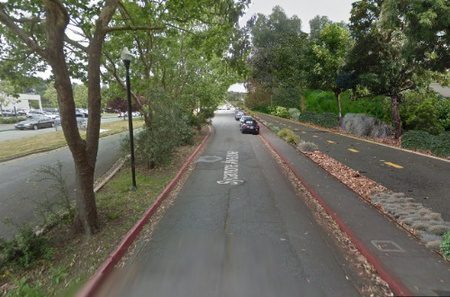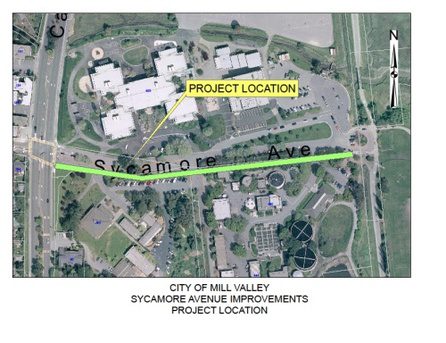“These projects are going to improve the central connections for kids coming to school from all different directions,” said Mill Valley Mayor Stephanie Moulton-Peters, the chair of the Southern Marin Task Force for Safe Routes To Schools. “These new multi-use paths will really change the way we, and most importantly our kids, move around town.”
Both projects date back to at least 2008, when they were identified as priorities by the City’s Bicycle and Pedestrian Committee. “This has been a top priority for the committee for many years – we’ve been trying to find the funding to build something and now we’re ready,” Director of Public Works Jill Barnes said.
Work Begins in June
The construction kicks off soon after school ends on June 17, beginning with the Sycamore Avenue project, which involves building a separated multi-use path along the southern stretch of Sycamore Avenue. The first phase of that project actually finished on March 3 with the removal of eucalyptus trees fronting the Wastewater Treatment Plant. The trees will be replaced with native, non-invasive species with lower fire risks associated with them.
The Sycamore Ave. path has a projected cost of $468,464, funded by Measure A sales tax revenue ($129,000), Federal Transportation Enhancement funding ($249,654) plus matching fund from the state ($32,346), and other local funds ($57,464).
Soon after the beginning of the Sycamore project, work will begin adjacent to the northbound lanes of Camino Alto, where a 10-foot-wide, multi-use path will be built for the entire stretch from Miller Avenue to Sycamore Avenue.
The Camino Alto project has an estimated cost of $606,914, primarily coming from Federal Safe Routes to School Program funding ($565,286), with some additional local funds. Both projects are projected to last about 30 days. “We expect to have these facilities ready when students come back to school in August,” Barnes said.
Alisha O’Loughlin, the Planning Director for the Marin County Bicycle Coalition, credited City officials for their leadership in moving both projects forward. O’Loughlin noted that the two new paths will link Tam High and the Mill Valley Middle School to the multi-use path, “giving our children a safe and separate from traffic path of travel to school,” she said. Hopes are high that this new path will allay many parents’ fears about allowing children to ride their bikes to school.
Bicycle Roundabout
In September after the two projects are finished, the County of Marin’s Public Works Department will complete the direct link to the multi-use path by building a bicycle roundabout at the intersection of Sycamore and the path.
Scott Schneider, an Associate Civil Engineer with the County’s Public Works Department, said the County is working to finalize a roundabout design, incorporate input from the Mill Valley Parks and Recreation Commission, the Mill Valley Bicycle and Pedestrian Advisory Committee as well as Marin County Parks, which maintains the path and much of the Bothin Marsh Open Space Preserve through which the path weaves.
Because work on the roundabout will be happening after the 2014-2015 school year begins, the County will pave a temporary bypass on the eastern edge of the path to allow for safe north-south travel on the multi-use path, Schneider said. The $250,000 project is expected to take two months to finish.
One of the goals of the roundabout is to improve safety and reduce tension on the path, where the interface of many different types and large numbers of users often creates friction. There are well over a half-million people who use the path between March and November each year and as many as 700 pedestrians and bicyclists use it over a two-hour period each day, according to the annual WalkBikeMarin Path Counts.
Schneider said the trio of new links to the multi-use path are a big step, particularly because an update of the path itself is at least two years away. Extending from Vasco Court near Edna Maguire School all the way south to Mike’s Bikes in Sausalito, the path was built in 1981, more than four decades after the Northwestern Pacific railroad stopped using the tracks the path replaced. Other than minor touch-ups, it hasn’t been repaved since it was built.
The Marin County Board of Supervisors voted to accept a $320,000 state grant more than three years ago to repave the path, and the Transportation Authority of Marin backed another $320,000 of federal money for the path rehab in Sept. 2013.
But, because of other funding hurdles and delays – a repaving of the path has an estimated price tag of $1.75 million – and deadlines to use some state and federal funding, money has been diverted to shovel-ready projects like the update of the multi-use path that runs past Bacich School and College of Marin near Kentfield.
Some of the delay is also a result of the tension around safety, since so many different user groups are on the path at the same time. The challenge is providing a path that is useful and safe for all – from fast-moving cyclists to pedestrians, the very young, as well as the elderly. Those safety concerns have caused Marin Parks officials to explore the possibility of widening the path, Schneider said.
The County has $640,000 of the estimated $1.75 million it will need to repave the entire path. The work ahead entails hiring an environmental consultant to explore the environmental impacts of a simple repaving and a larger widening project and determine the feasibility of each. That process, which will allow regulatory agencies like the San Francisco Bay Conservation and Development Commission, the National Marin Fisheries Service and California Fish & Wildlife to weigh in, can begin in late summer and will likely take up to two years, Schneider said. That process will determine if the County proceeds with a repaving project or a widening of the path as well, he said.
In the meantime, Mill Valley residents and visitors are expected to have a pair of safe new pathways to travel to and from the multi-use path.
“We’re looking forward to celebrating their completion,” O’Loughlin said.
Want to know what’s happening around town? Click here to subscribe to the Enjoy Mill Valley Blog by Email!





